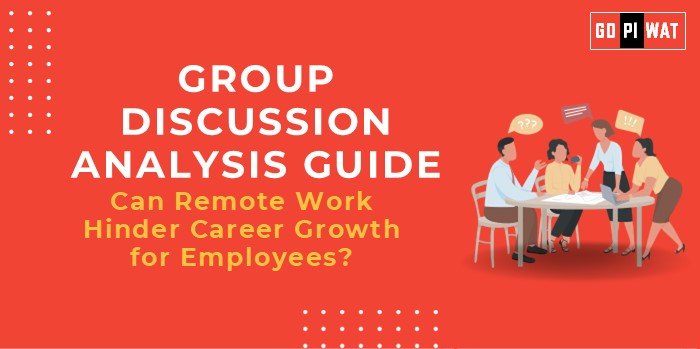📋 Group Discussion (GD) Analysis Guide: Can Remote Work Hinder Career Growth for Employees?
🌐 Introduction
Opening Context: The rise of remote work, accelerated by the COVID-19 pandemic, has fundamentally changed work dynamics worldwide. While remote work offers flexibility and better work-life balance, concerns about career stagnation have emerged.
Topic Background: Before the pandemic, remote work was a privilege limited to specific industries. Post-2020, over 60% of global workers experienced remote work (McKinsey, 2023), sparking debates on whether remote work affects employee visibility, skills development, and promotions.
📊 Quick Facts and Key Statistics
- 🌍 Hybrid Work Adoption: 74% of companies globally plan to adopt a hybrid work model (Gartner, 2023).
- 📈 Promotion Trends: Remote workers are 25% less likely to receive promotions compared to on-site peers (Stanford, 2022).
- 👥 Employee Preference: 87% of workers prefer flexible work options (PwC, 2023).
- 📚 Skill Development Impact: Remote workers report 36% fewer opportunities for informal mentorship and skill growth (LinkedIn, 2023).
🤝 Stakeholders and Their Roles
- Employers: Balance productivity and employee career development through structured remote systems.
- Employees: Maintain proactive visibility, upskill, and engage in virtual networking to avoid stagnation.
- HR Departments: Create fair evaluation systems that eliminate remote work bias.
- Industry Leaders: Set benchmarks for inclusive growth in hybrid/remote environments.
🏆 Achievements and Challenges
Achievements
- Increased Flexibility: Enables better work-life balance and global talent access.
- Productivity Gains: Companies like Microsoft and Google report 7-15% productivity improvements with flexible work.
- Cost Savings: Businesses save up to 30% on infrastructure, while employees save on commuting.
Challenges
- Reduced Visibility: 45% of managers admit favoring in-office workers during evaluations (Forbes, 2023).
- Limited Networking: Remote settings hinder informal interactions crucial for mentorship.
- Skill Gaps: Fewer growth opportunities due to lack of exposure to high-impact projects.
📜 Structured Arguments for Discussion
- Supporting Stance: “Remote work hinders career growth as it reduces face-to-face interactions, mentorship opportunities, and visibility, which are critical for promotions.”
- Opposing Stance: “Remote work does not hinder career growth; instead, it fosters productivity and allows employees to focus on measurable performance outcomes.”
- Balanced Perspective: “While remote work offers flexibility and cost benefits, its success depends on inclusive evaluation systems, mentoring programs, and equal growth opportunities.”
💡 Effective Discussion Approaches
- Opening Approaches:
- Statistical Opening: “Did you know remote workers are 25% less likely to be promoted than on-site colleagues?”
- Question-Based: “Can productivity gains from remote work compensate for career stagnation risks?”
- Counter-Argument Handling:
- Challenge: “But remote work reduces visibility.”
- Response: “Visibility challenges can be overcome with structured performance metrics and virtual mentorship programs.”
📈 Strategic Analysis of Strengths and Weaknesses
- Strengths: Flexibility, cost savings.
- Weaknesses: Reduced informal learning opportunities, bias in evaluations.
- Opportunities: Remote-friendly mentoring tools, equal promotion policies.
- Threats: Career stagnation, employee disengagement.
🎓 Connecting with B-School Applications
- Real-World Applications: Operations: Creating balanced hybrid work strategies; HR: Implementing bias-free evaluations.
- Sample Interview Questions:
- “How can companies prevent career stagnation for remote employees?”
- “Discuss the impact of remote work on organizational culture and productivity.”
- Insights for B-School Students: Emphasize innovative approaches to balance flexibility with professional growth.


